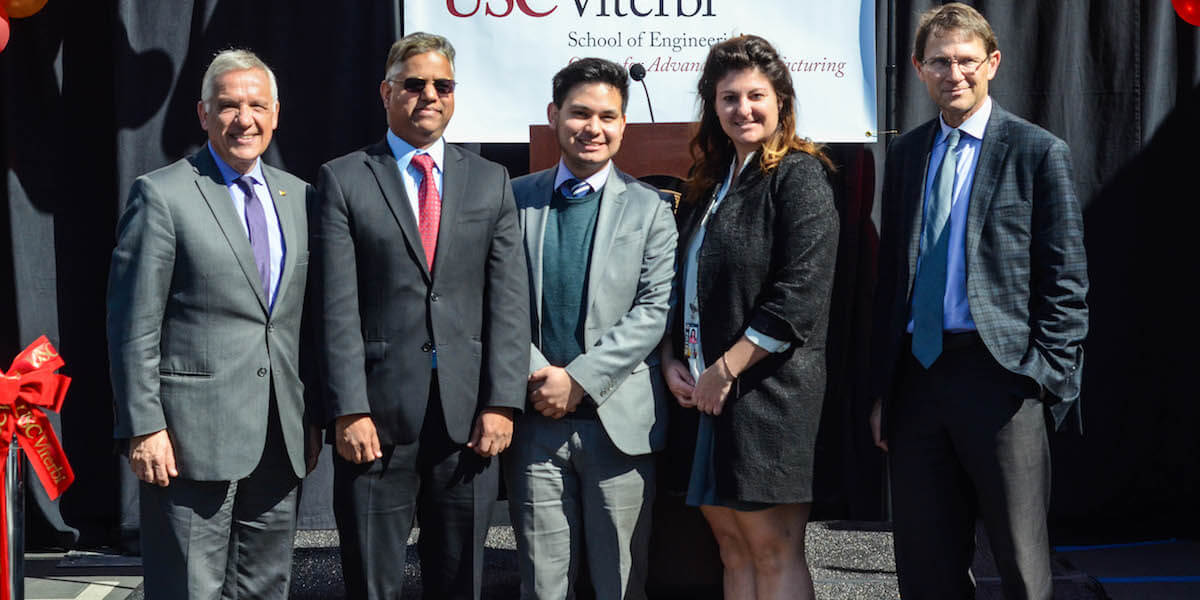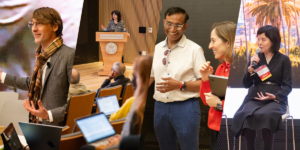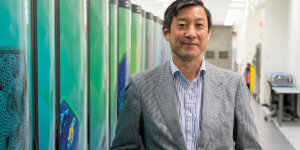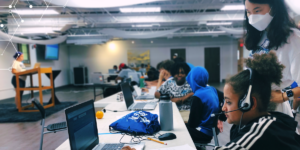
(Left to right) USC Viterbi Dean Yannis C. Yortsos, SK Gupta, Fernando Delgado of Supervisor Hilda Solis’s office, Adrienne Lindgren of Mayor Eric Garcetti’s office, and USC Vice President of Research Randy Hall (Photo by Peter Shin)
The USC Viterbi Center for Advanced Manufacturing (CAM), a future regional hub for technological innovation, launched Friday, Feb. 24 before an enthusiastic audience of about 100 guests.
The center, the only academic facility of its type in greater Los Angeles, will allow USC Viterbi to collaborate with emerging and local businesses to spur job growth and fuel the economy. That’s especially true, as advanced manufacturing becomes an increasingly integral part of the emerging Silicon Beach ecosystem.
“The opening of [CAM] represents our commitment to play an integral role in this rapidly unfolding future – locally, nationally and internationally- and to help understand it, shape it and mold it for the collective benefit,” USC Viterbi Dean Yannis C. Yortsos said.
“The Center for Advanced Manufacturing is the convergence of the physical, chemical, informational, perhaps biological and, certainly societal worlds,” he added. “CAM will be a place for understanding new technologies in making things; a crucible for innovation and new discoveries; and a classroom for teaching and training.”
This “absolutely visionary center,” said Randolph Hall, the USC’s vice president of research and a professor in the Daniel J. Epstein Department of Industrial and Systems Engineering, “brings the pieces together.”
CAM features a design studio, a machining lab equipped with 3-D printers, laser cutters, industrial robots and automation equipment. In addition, the center has a classroom for training and instruction of undergraduates, graduate-level students, as well as the community.
At the launch party, several USC Viterbi graduate students showed off cutting-edge technologies inside CAM’s cavernous workspace. As audience members gathered round, one student gave a demonstration of an automated robotic arm installing miniature jet engine blades into a rotor. A robot shaped like an alligator, and programmed to simulate its movements, scurried across a table. Nearby, a 3-D printer built a small plastic propeller layer-by-layer.
Automated high-end manufacturing – a software and data-driven approach to building things that promotes greater efficiencies, flexibility and mass customization without increasing costs – will create scores of high-paying jobs in engineering services, creative design, finance, construction and service positions, said Satyandra K. (SK) Gupta, CAM founding director and the Smith International Professor in the Aerospace and Mechanical Engineering Department.
Many of those good jobs will likely be located in Southern California. In a virtuous economic circle, those positions will create new ones with the increased demand for engineering services, accountants, attorneys, real estate etc., leading to even more hiring.
Perhaps most important, Gupta added, the robots fueling much of advanced automation will free knowledge workers up to think, create and innovate. They are “tools to enhance human capabilities,” he said.
CAM’s launch comes at a time when, according to Gupta, we are entering a “golden age” of manufacturing, one in which the US will become a leader in many high-end, highly profitable sectors.
“With America’s computing expertise and technological know-how, there is no reason that the US can’t play a major role in the production of drones, advanced batteries, driverless cars and biomedical devices,” he said. “And because the robots and 3-D printing machines used in advanced manufacturing cost the same in the United States as in China or Mexico, much of the production of the Fourth Industrial Revolution could take place in America.”
Gupta became interested in automation as a mechanical engineering student in India. In 1987, he interned on a truck company’s automated assembly line. Gupta later studied manufacturing and automation as a Ph.D. student at the University of Maryland, where he went on to become a professor.
Gupta’s work itself is helping to fuel those changes. His current research includes developing ways to enable the deployment of robots on non-repetitive tasks in manufacturing, a potential major breakthrough.
Published on March 6th, 2017
Last updated on February 11th, 2021













